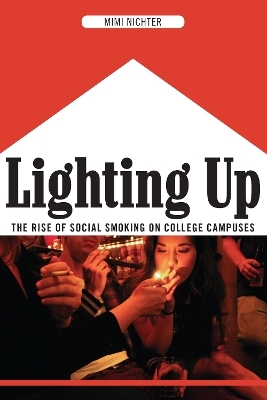
Lighting Up
New York University Press (Verlag)
978-0-8147-5838-0 (ISBN)
While the past 40 years have seen significant declines in adult smoking, this is not the case among young adults, who have the highest prevalence of smoking of all other age groups. At a time when just about everyone knows that smoking is bad for you, why do so many college students smoke? Is it a short lived phase or do they continue throughout the college years? And what happens after college, when they enter the “real world”? Drawing on interviews and focus groups with hundreds of young adults, Lighting Up takes the reader into their everyday lives to explore social smoking.
Mimi Nichter argues that we must understand more about the meaning of social and low level smoking to youth, the social contexts that cause them to take up (or not take up) the habit, and the way that smoking plays a large role in students’ social lives. Nichter examines how smoking facilitates social interaction, helps young people express and explore their identity, and serves as a means for communicating emotional states. Most college students who smoked socially were confident that “this was no big deal.” After all, they were “not really smokers” and they would only be smoking for a short time. But, as graduation neared, they expressed ambivalence or reluctance to quit. As many grads today step into an uncertain future, where the prospect of finding a good job in a timely manner is unlikely, their 20s may be a time of great stress and instability. For those who have come to depend on the comfort of cigarettes during college, this array of life stressors may make cutting back or quitting more difficult, despite one’s intentions and understandings of the harms of tobacco. And emerging products on the market, like e-cigarettes, offer an opportunity to move from smoking to vaping. Lighting Up considers how smoking fits into the lives of young adults and how uncertain times may lead to uncertain smoking trajectories that reach into adulthood.
Mimi Nichter is Professor in the School of Anthropology, University of Arizona where she holds joint appointments in the Norton School of Family and Consumer Sciences and the College of Public Health. She is the author of Fat Talk: What Girls and Their Parents Say About Dieting.
Contents Acknowledgments ix 1. "It's No Big Deal" 1 2. Profiles and Progressions 24 3. Smoking and Drinking: "It's Like Milk and Cookies!" 45 4. What's Gender Got to Do with It? 74 5. Reconsidering Smoking as a Weight-Control Strategy 101 6. The Slippery Slope 120 7. Tipping Points: Stress, Boredom, and Romance 148 8. Quit Talk 169 9. Looking Forward: Uncertain Trajectories 194 Appendix: Methods 207 Notes 219 References 233 Index 253 About the Author 263
| Verlagsort | New York |
|---|---|
| Sprache | englisch |
| Maße | 152 x 229 mm |
| Gewicht | 567 g |
| Themenwelt | Medizin / Pharmazie |
| Sozialwissenschaften ► Pädagogik ► Erwachsenenbildung | |
| Sozialwissenschaften ► Soziologie | |
| ISBN-10 | 0-8147-5838-X / 081475838X |
| ISBN-13 | 978-0-8147-5838-0 / 9780814758380 |
| Zustand | Neuware |
| Haben Sie eine Frage zum Produkt? |
aus dem Bereich


